What are Africa Big Five? Meet Africa’s Iconic Wildlife
On an African safari, “the Africa Big Five” is a term you will hear a lot. So what are the Big Five? The Big Five are some of Africa’s most iconic large mammals: the lion, the leopard, the Cape buffalo, the elephant, and the rhinoceros.
Once mostly targeted by hunters, these large species are “awe-inspiring” sights for safari-goers. The term, coined in the late 1800s during Africa’s colonial period, refers to what trophy hunters considered the most challenging and dangerous animals to hunt on foot.
Whilst rampant big-game hunting has been largely consigned to history, unfortunately, poaching has taken its place and it’s the rhino in particular that has suffered as a result.
Accordingly, the number of places in Africa where you’ll have the opportunity to see the Big Five has fallen considerably. However, there are places in Kenya where rhino populations are still strong so it’s still possible with a bit of luck.
In the north of Kenya, most notably Lake Nakuru, Ol Pejeta Conservancy and the Lewa Wilderness Conservancy, rhinos can still be seen, allowing you to see all of the Big Five.
These areas are relatively small in comparison to other parks so your chances of seeing these animals are increased, although the leopard always seems to remain elusive and so an element of luck is required to see one.
Finally, Kenya’s most famous reserve, the Masai Mara, is also home to the Big Five, but due to its sheer size the animals are more spread out and the chances of seeing them all are more limited.
The Big Five animals are the standouts of any African safari, the wildlife that for many define what a journey to the savannah is all about.
A Dive into the African Big Five
The Lion: King of the Jungle

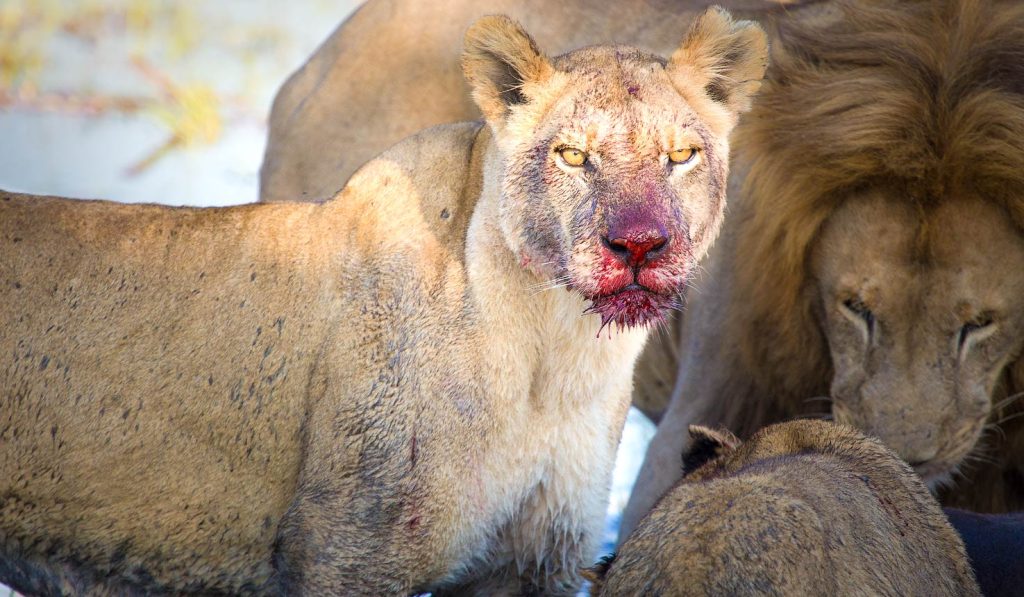
It would be difficult to go on safari without expectations of seeing the ‘king of the jungle’. Fortunately, several of Kenya’s parks feature multiple prides of lions. The Tsavo Parks are home to the appropriately named Tsavo lions, a fascinating sub-species whose males sport unusually short manes.
Samburu Park to the north also offers safari-goers a chance to see the fearsome felines as does Amboseli Park on the Tanzanian border.
But for the sheer number of pride and therefore individual lions, a visit to the Masai Mara is essential. The park and its surrounding conservancies offer the best chance to watch these great predators on the prowl, especially during the season (July – October) of the Great Migration.
With an estimated kill of over 15 big animals per year, it comes as no surprise that the lion is dubbed the king of the ‘jungle’. Africa alone has over 20,000 lions, making the continent your safest bet for lion safaris yet. Here are ten facts about lions that you should know as you look forward to your African safari adventure.
- Lions have a lifespan of 10-14 years
- Female lions do most of the hunting. Take that, male chauvinists!
- This might come as a heartbreak to the Lion King fans, but lions do not live in the jungle. They are found on the savannah grasslands
- You can hear a lion roar from as far as 8 km away. Talk about that mighty roar!
- That lion’s power comes from power naps that can last for over 20 hours per day.
- Male lions typically weigh 190kgs while female lions weigh 130kgs
- Lions have a maximum speed of 80km/h
The rate at which lion populations are dwindling worldwide has got the animal on the UN red alert
The African Elephant
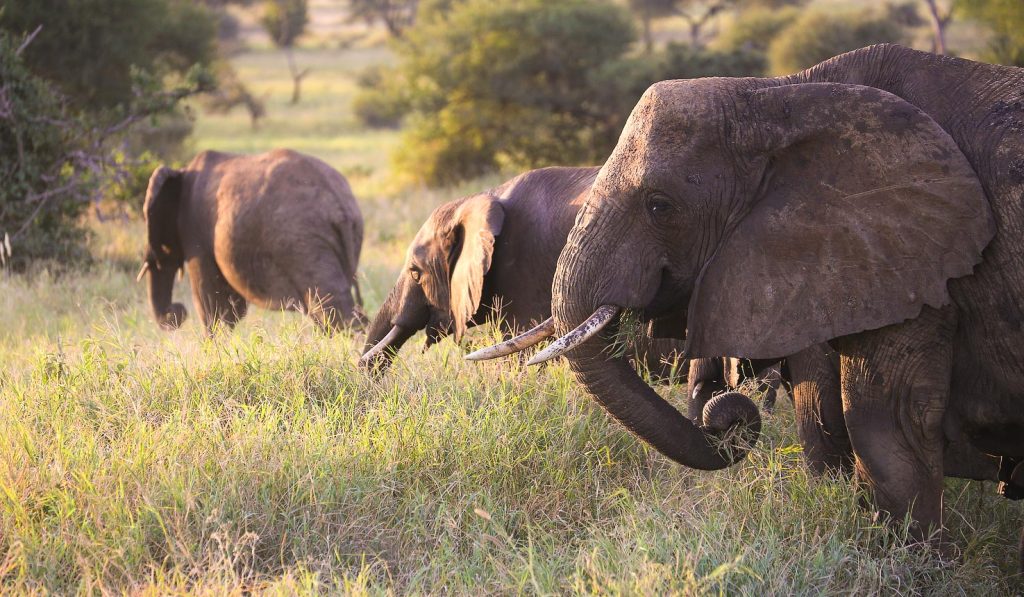

Perhaps the most beloved of the “Big Five” and maybe all of Africa’s wildlife, the mighty elephant marches through most of Kenya’s wildlife parks. You’ll see the towering pachyderm, often in family groups parading to and from their watering holes. An herbivore, the elephant is often spotted tearing off great branches of leaves on which to feed.
Samburu Park boasts an elephant population of almost 1000. However, Amboseli, a smaller park has such a huge density of elephants that you are guaranteed to see them… and probably many times during your visit.
Disney has half the world fooled with that elephant-are-afraid-of-the-mouse tale. Here are 5 legit elephant facts.
- There are close to 500,000 elephants in Africa
- Adult elephants have no prey. Baby elephants, however, are at risk of predator attacks.
- There are 3 species of elephants; the Asian, African savannah, and African forest elephant. So no, an elephant isn’t just an elephant
- We’ll tell you why you should not be under an elephant. Male elephants are as heavy as 7500kgs while female elephants can weigh up to 6,000kgs.
- Think of elephant tusks as your incisors under enlargement. Elephant tusks are just elongated incisors
The Elusive Leopard
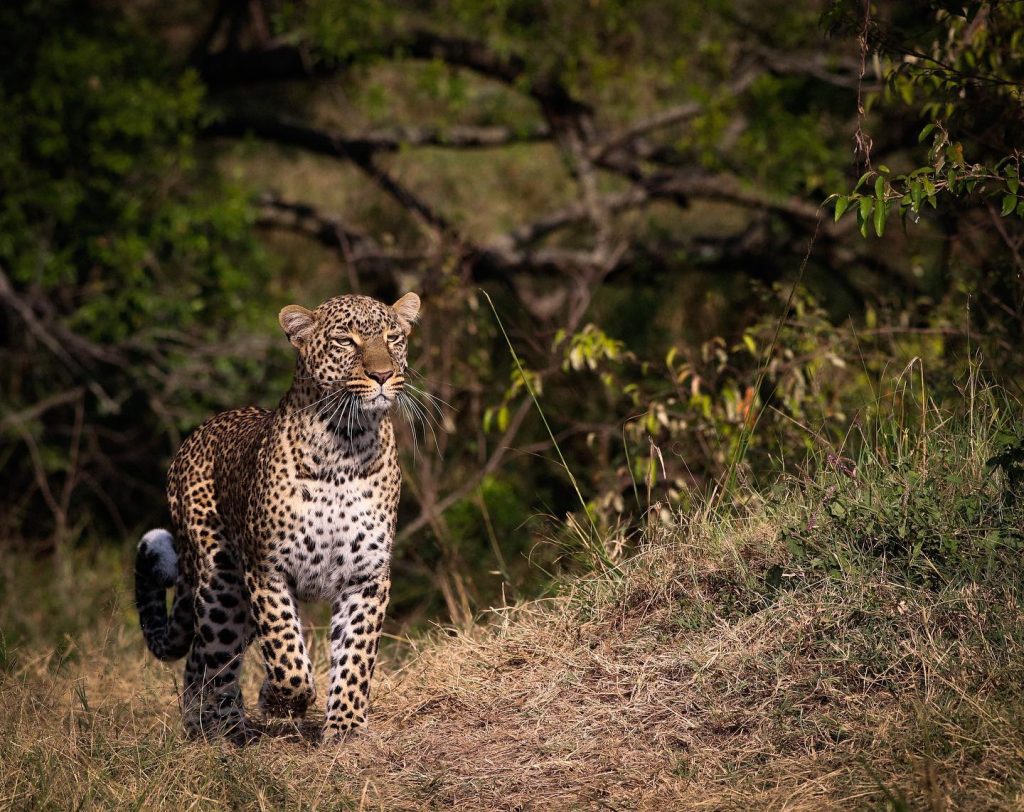
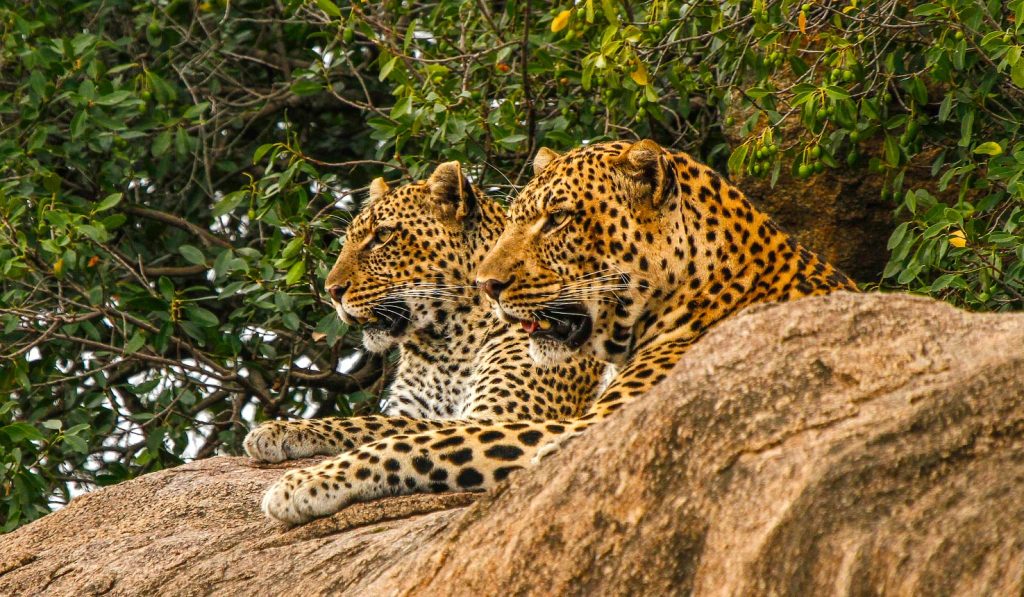
Sleek and mysterious, the leopard is a night hunter, on the prowl between sunset and sunrise. From its natural perch high on a tree branch, this graceful predator scans the horizon for its usual prey of grazers – antelope, gazelle, zebra, or wildebeest.
Leopards are found in the Masai Mara, Amboseli, and Tsavo Parks but also in smaller reserves like Lake Nakuru National Park and Ol Pejeta Conservancy. At Ol Pejeta you can go on nighttime safaris which increases your chances of a sighting.
The leopard is a ruthless killer as it is a hunter. They slowly and quietly stalk their prey until a range of 10m is achieved. They then pounce on the unsuspecting prey, killing them with a lethal throat bite. Here are five more interesting facts about leopards.
- Leopards have a 12-17 year lifespan
- Most leopards have light-coloured fur with dark rose-shaped spots known as rosettes. Dark-furred leopards do exist, though their dark colour makes it hard to view the spots around their fur.
- Leopards can run as fast as 58km/h. Their 6-meter forward leap is also as impressive
- Leopards are nocturnal prey, preferring to spend their days in trees or caves. They are more active during the night though, which is when they go hunting.
- Leopards are highly territorial, choosing to strictly limit their interactions to mating only.
The Cape Buffalo


This fierce animal is the only one of the “Big Five” that isn’t endangered or considered vulnerable. Amongst hunters, it was always considered the most dangerous as it was easily provoked and would charge its pursuers, especially when wounded.
You’ll find this distinctive and sometimes ornery horned bovid in almost all of Kenya’s wildlife parks.
You are twice more likely to be killed by a cape buffalo than a lion? Interesting? Here are 5 more fascinating facts about cape buffaloes
- Buffaloes are extremely moody. A calm buffalo can charge at you within seconds.
- Four times stronger than an Ox, a buffalo is more likely to win in a fight with a lion. Well, not surprising seeing that cape buffaloes are as tall as 11 feet with a maximum weight of 1900 pounds and dagger-like horns.
- Buffaloes are surprisingly good swimmers
- Male cape buffaloes weigh anywhere between 650-800kgs while female buffaloes weigh between 550-700kgs
- Buffaloes have a lifespan of about 18-20 years
The Shy Rhino
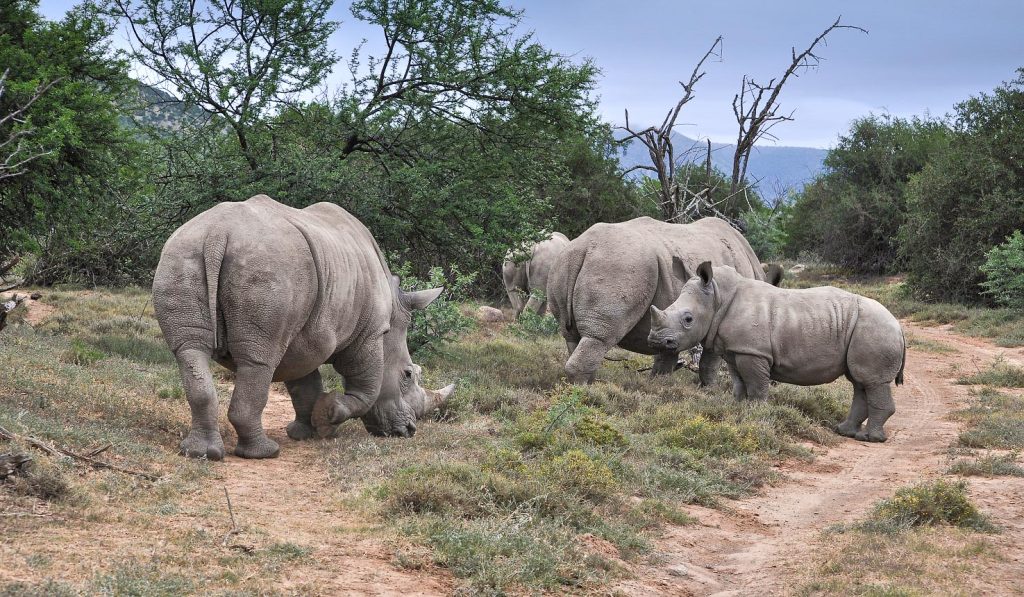
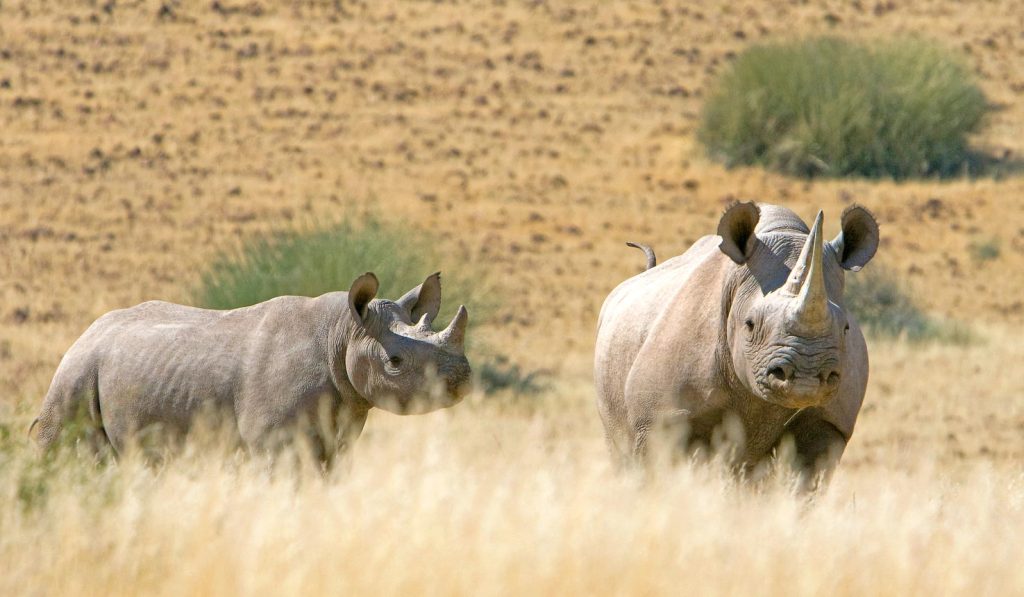
With its huge hulking body and unique set of horns rising from its nasal bridge, the big rhino is a special treat to witness. Despite their great form and threatening appearance, rhinos are quite shy, and finding them in the wild is not always easy.
Of the “Big Five”, the rhino is the most endangered so special sanctuaries have been created for their protection from poachers and to nurture back the dwindling population.
You’ll find rhinos in most of the wildlife parks but especially in the sanctuaries harboured at Nairobi National Park, Ol Pejeta, and Lake Nakuru.
Forget the white rhino-black rhino philosophy, both come in the same grey colour. Here are five more interesting facts about rhinos.
- The rhino is the second largest mammal on land with the black rhino weighing anywhere from 1000kgs and the white rhino from 3500kgs.
- Rhinos can run as fast as 30km/hour over short bursts!
- Running in a zigzag to escape a rhino is not a midwife’s Due to their humongous size rhinos cannot only run in a straight line.
- Hard as the rhino horn may look, it is made from the same material your nails are made of.
- Rhinos reportedly have very small brains but make no mistake, these creatures are as intelligent as dogs.
Where to Find Africa Big Five Safari Animals in Kenya
The big five animals can all be found in the African savannah and bushland. Other inhabitants such as national parks, game reserves and other protected areas are also great places to spot the big five animals. Our focus in this post is best places to find them:
On the eastern side of Africa lies Kenya. A country proud of being home to the Masai Mara Game Reserve, the Diani Beach, and over 52 national parks and game reserves. It is also while in this East African country that you will find Mt Kenya, the second-highest mountain in Africa.
Particularly stunning, however, is its high appeal and adaptation to being the leading Big Five safari destination in Africa. As mentioned, the country boasts slightly over 52 national parks, a large majority of which house the Africa Big Five animals.
The best national parks for game drives in Kenya are:
- The Masai Mara Game Reserve
- The Amboseli National Park
- The Tsavo East National Park
- The Lewa Conservancy
- The Lake Nakuru National Parks
- The Nairobi National Park, and more.
The Mara needs little introduction. The park outdoes itself when it comes to iconic grassland savannas, hot air balloon safaris, and the show-stopping Wildebeest Migration.
More than 100 wildlife species thrive in the Mara including lions, elephants, leopards, cheetahs, wild dogs, hyenas, rhinos, hippos, wildebeests, and more. On a safari in Masai Mara, your Big 5 game viewing chances are at the highest.
Big Five safari adventures in Kenya come in all shapes and prices;
- Budget safaris average at $200 per person sharing
- Mid-range/ Standard safaris at $300 PPS
- Luxury safaris at \$550+ per person sharing
Kenya should be your African country of choice if what you are looking for is fulfilling, fun, and adventurous Big Five safaris.
Best Time to Visit Kenya
The months of July through September are the best months to visit Kenya for several reasons. First, the mentioned months are dry and wildlife is way easier to spot during the dry seasons. Secondly, the extraordinary Wildebeest Migration, July to October, falls within the months.
Other Fives
Africa is incredibly rich in wildlife, which is why several other “fives” have popped up over the years, such as the Little Five—including the leopard tortoise and the elephant shrew—the Shy Five, and the Ugly Five, which, to say the least, is a bit subjective.

